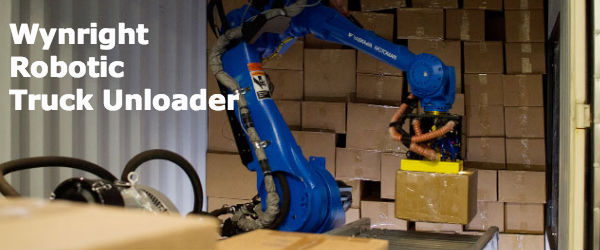Wynright Get NextGen Game Changer Award For Robotic Truck Unloader
 Wynright Corporation, a wholly owned subsidiary of Daifuku Webb and a leading U.S.-based provider of intelligent material handling systems, has been named the winner of the NextGen Game Changer Award for its Robotic Truck Unloader (RTU).
Wynright Corporation, a wholly owned subsidiary of Daifuku Webb and a leading U.S.-based provider of intelligent material handling systems, has been named the winner of the NextGen Game Changer Award for its Robotic Truck Unloader (RTU).
According to Robotics Business Review, the NextGen category of the Game Changer Award is given to the company with the most revolutionary up-and-coming robotics products. The RTU was selected for this honor by a distinguished panel consisting of experts from the International Journal of Advanced Robotic Systems, the business and investment community, and editors from Robotics Business Review and Robotics Trends. The award was presented to Wynright October 23, 2013 during a banquet at the RoboBusiness event in Santa Clara, California.
“While much of the warehouse or distribution center has been automated, the last mile – the loading dock – still remains a largely manual operation in the supply chain,” said Kevin Ambrose, CEO of Wynright Corporation. “Much of that has to do with the number of variables encountered when loading or unloading a truck. Most robots are designed for a single, repetitive task. Our goal was to develop a self-propelled robotic unit that could recognize variables such as size, shape and how products are stacked in a trailer or sea container, and make intelligent decisions about the best way to take them off the stack and place them on a conveyor. This award is further validation that what we’re doing is both unique and valuable to our customers.”
One of the keys to the success of Wynright’s RTU is its innovative use of 3D vision technology – the same type used in video games such as Xbox Kinect. When the RTU approaches a wall of cartons it scans the façade in three dimensions and then uses an algorithm to determine the best way to grip and move the carton onto a conveyor, where it can be introduced into the rest of the material handling system.
Wynright designed the RTU so a single operator can manage up to three units simultaneously. The operator need only be present to get the RTU started, and to solve any problems the unit cannot solve for itself, such as handling a carton that was damaged in transit. When this occurs, the RTU alerts the operator who then returns to the dock to resolve the situation. Use of the RTU helps reduce labor costs while giving dock workers a higher-paying, more valuable skill. It also improves working conditions on the dock.
“Loading and unloading trailers and containers is uncomfortable, difficult work for human beings,” Ambrose said. “Since there are no environmental controls, it can get incredibly hot during a Texas summer or incredibly cold in a Montana winter. It’s also very difficult on the legs, shoulders and back. But the work still has to get done. The RTU allows enterprises to redeploy dock personnel to other, less taxing jobs, thereby creating a better, safer work environment while still ensuring a smooth flow of goods through the system.”
Category: Featured, General Update










